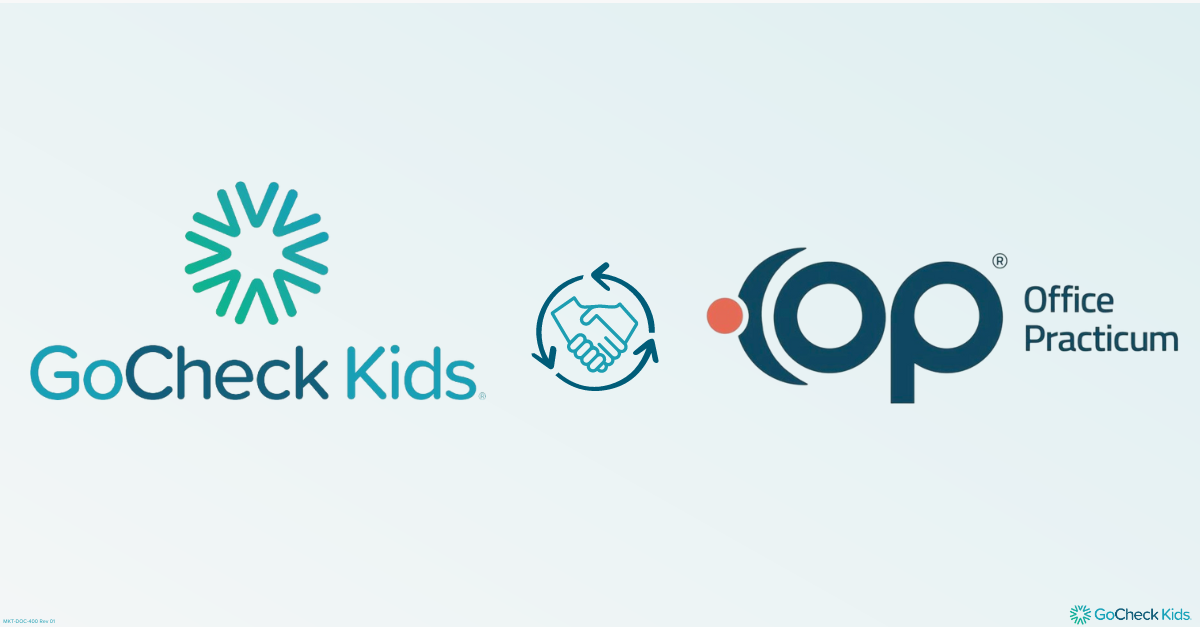
How the AAP Vision Screening Guidelines Help Reduce Amblyopia Risk
In January 2016, the American Academy of Pediatrics (AAP) released the “Visual System Assessments in Infants, Children, and Young Adults by Pediatricians”.1 This comprehensive clinical report is an updated vision screening policy statement for pediatricians. It was
co-authored by the AAP and the American Association for Pediatric Ophthalmology
and Strabismus (AAPOS), among others.
A significant update: Instrument-based vision screening, performed using a photoscreener, is recommended as a clinically valid method to fill a care void.
Why? When you photoscreen, you catch vision issues early, when treatment is most effective.
Learn why the AAP updated its vision screening guidelines to recommend photoscreening and ensure you have the knowledge to meet the guidelines and provide the best care for your patients.
Why Did the AAP Recommend Photoscreening for Pediatricians?
The Risks of Late Amblyopia Discovery
Vision impairment is one of the most prevalent disabling conditions among children.2 A principal reason is amblyopia; the #1 cause of preventable vision loss in children.3 Regular vision screening assessments in early childhood reduce the risk of persistent amblyopia at 7 years of age by more than 50%.4 Additionally, the most common type of amblyopia, refractive amblyopia, is often invisible to both parents and pediatricians.5
What this means: if you wait until a patient can perform a visual acuity test (e.g., Snellen chart) you run the risk of detecting amblyopia risk factors when treatment outcomes are much lower and learning has already been negatively affected.
Why the Bruckner Test Isn't Enough for Eye Screening
A common misconception we hear among pediatricians is that a Bruckner test is sufficient for finding refractive disorders in young patients.
Although red reflex testing with an ophthalmoscope can detect high refractive errors, photoscreeners are designed with the referral criteria suggested by AAPOS. This referral criteria is specific for refractive errors that indicate a risk for amblyopia.6
Furthermore, a 2001 study by Evelyn Passe found a significant difference in the accuracy of detection of amblyopia using the Bruckner red reflex test (65%) and a photoscreener (82%).7 Since then, photoscreening technology has vastly improved.
Visual Acuity Tests for Young Children: Are They Accurate?
Studies also suggest that children cannot fully comprehend a visual acuity test until they are 5 or 6 years old.
In a 2008 study, for example, April Salcido found a 0% positive predictive value for traditional screening methods like a Snellen chart exam for 3 and 4-year-olds. In comparison, photoscreening had a 73% positive predictive value for the same age.8
The study concluded that photoscreening is more time efficient than traditional screening and has a significantly higher PPV in 3 and 4-year-old children.
What Stops Doctors from Photoscreening?
There are three primary reasons a low percentage of pediatricians are meeting AAP care standards.
1. The Awareness Gap
The awareness gap is a challenge we can address by sharing this article and the AAP policy statement with the pediatric community. If you are already photoscreening, share your experiences with your peers. Through increased knowledge, more pediatricians will become aware of this recommendation and consider adopting photoscreening in their practices.
2. High Cost
In the 2012 AAP vision screening policy update “Introduction of Instrument-Based Screening,” economics was cited as the primary barrier to photoscreening:
“The instruments (photoscreeners) themselves often cost thousands of dollars, in addition to the costs of printers and supplies for each test performed. There are additional indirect costs, including space and staff time required to perform these tests, as well as physician time to interpret them.”10
In our experience at GoCheck Kids, speaking with peds about photoscreening, cost remains a major barrier.
3. Variable Reimbursement
Photoscreening is reimbursed via CPT codes 99174 and 99177.
Due to USPSTF recommendations and the periodicity schedule, many commercial payors cover these procedures. However, as of 2023, only 28 states plus DC cover photoscreening and instrument-based screening through Medicaid.
To tackle this issue, GoCheck Kids has collaborated with entities such as the AAP, children’s hospitals, and other healthcare providers, advocating at a state and federal level for increased reimbursement of visual acuity and instrument-based photoscreening. Through these partnerships, awareness has been raised, and support has been garnered among members of Congress and the Senate, urging the Centers for Medicare & Medicaid Services (CMS) to take necessary actions both with MACPAC and with individual states.
In speaking with Dr. Thomas Spain about this issue, he said this:
"In my experience, working with pediatricians across the United States, Medicaid Reimbursement remains the primary barrier to more widespread adoption of instrument-based visual screening in pediatric primary care. Children covered by Medicaid plans include those US children who are most likely to have vision impairments and the least likely to receive vision screenings. Advocating for broader Medicaid coverage is a critical step in addressing this health disparity."
Thomas Spain, MD, MPH, FAAP
Chief Medical Officer, GoCheck Kids
A Better Method for Child Eye Health Checks
When it comes to meeting the AAP photoscreening recommendations, we understand that you may feel stuck due to high device costs and cumbersome workflow requirements.
However, there is a recommended solution that meets AAP, AAPOS and AAO recommendations for vision screening tests as early as 12 months of age. GoCheck Kids detects the presence of conditions that are risk factors for Amblyopia (lazy eye), including:
- Hyperopia (farsightedness)
- Myopia (nearsightedness), and
- Anisometropia (asymmetrical refractive power).
In his 2016 AAP policy statement9, Dr. Sean Donahue said this about GoCheck Kids:
“The availability of GoCheck Kids is particularly intriguing. Its photoscreening functionality efficiently detects risk factors for amblyopia in real time. A real advantage of GoCheck Kids is that it is a mobile application and, therefore, portable, affordable, and easily accessible… For a monthly subscription, a physician is provided unlimited utilization.”9
As a pediatrician, you know early detection can make a big difference. Get the easy-to-use AAP Guideline checklist and stay ahead in amblyopia detection and care.
References:
1. Donahue, S. P., and Baker, C. N., (2016). Visual System Assessment in Infants, Children, and Young Adults by Pediatricians. Pediatrics,137(1).
http://pediatrics.aappublications.org/content/pediatrics/137/1/e20153596.full.pdf
2. Centers for Disease Control and Prevention (2023). Fast facts about vision loss.
https://www.cdc.gov/vision-health/data-research/vision-loss-facts/?CDC_AAref_Val=https://www.cdc.gov/visionhealth/basics/ced/fastfacts.htm
3. Children’s Eye Foundation of AAPOS.
https://www.childrenseyefoundation.org/resources/vision-screening-saves-sight
4. Swanson, J., France, F., Grimm, K., et al. (2002). Use of Photoscreening for Children’s Vision Screening. Pediatrics, 109(3), 524–525.
http://pediatrics.aappublications.org/content/109/3/524.long
5. Jordan, C. O. (2020). What to Know about Amblyopia and Vision Loss in Children.
https://www.futureofpersonalhealth.com/vision-and-hearing/what-to-know-about-amblyopia-and-vision-loss-in-children/
6. Arnold, R. W., et al. (2022) AAPOS uniform guidelines for instrument-based pediatric vision screen validation 2021. Journal of AAPOS, 26 (1).
https://www.jaapos.org/article/S1091-8531(22)00009-X/pdf
7. Passe, E., Williams, G., Coats, D., and Williams, E. (2001). Detection of red reflex asymmetry by pediatric residents using the Brückner reflex Versus the MTI Photoscreener. Pediatrics, 108(4).
https://pubmed.ncbi.nlm.nih.gov/11581482/
8. Salcido, A. A., Bradley, J., Donahue, S.P. (2005). Predictive value of photoscreening and traditional screening of preschool children. Journal of AAPOS, 9(2), 114-120.
https://www.ncbi.nlm.nih.gov/pubmed/15838437
9. Donahue, S. P. (2016). The role of technology in routine vision screening of infants and young children – A new policy statement from the American Academy of Pediatrics (AAP) places heavy emphasis on photoscreening to detect treatable vision defects. Neonatology Today, 11(5), 1-4.
https://www.neonatologytoday.net/newsletters/nt-may16.pdf
10. Miller, J. M., and Lessin, H. R. (2012). Instrument-Based Pediatric Vision Screening Policy Statement. Pediatrics, 130(5), 983-986.
http://pediatrics.aappublications.org/content/130/5/983#ref-1
11. Donahue, S. P. (2017). The 2017 US Preventive Services Task Force Report on Preschool Vision Screening. JAMA Ophthalmology, 135(10), 1021-1022.
doi:10.1001/jamaophthalmol.2017.3373
MKT-DOC-378 Rev 01


